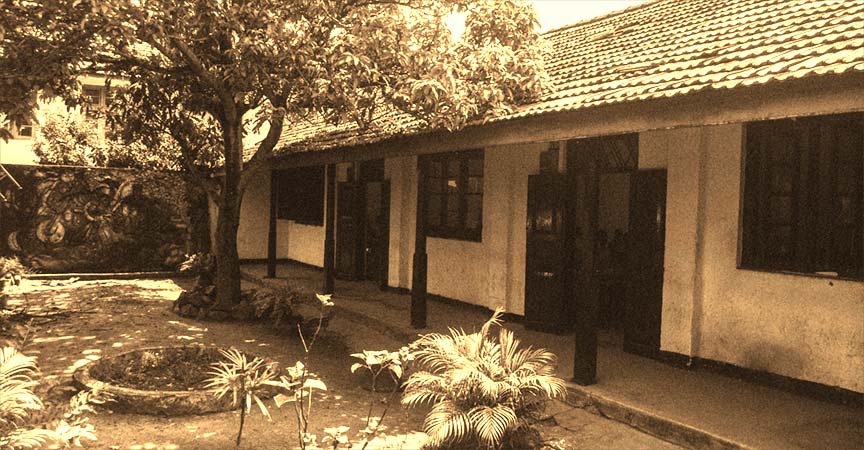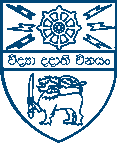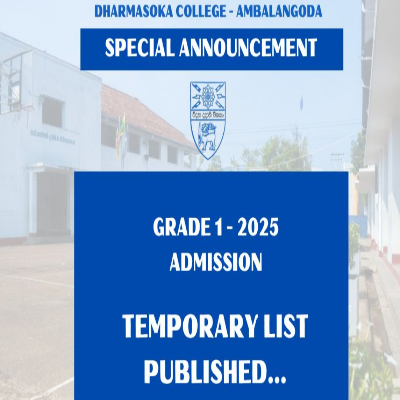HISTORY
BACKGROUND

History in the broadest sense means a totality of all past events. However, in narrating the history of an institution, it is prudent to limit the narration to past events and historical facts known through the testimony of living persons, from memoirs, literary works, and other records having a bearing on the institution.
It is unfortunate that no authentic records tracing the genesis and early history of Dharmasoka College are available in the school or elsewhere. However, this writer was able to have access to a few sources which threw some light on the origins of Dharmasoka College and its early history. These sources are gratefully acknowledged in this narrative and in the foot-notes.
The Great Debate of Panadura (1873), a landmark event in Sri Lankan history was the forerunner of the resurgence of Buddhism in the island in the latter decades of the 19th century. Shortly after this historic event, a booklet containing several articles on the Panadura Debate (published by Dr. J. M. Peebles, a Fellow of the Academy of Sciences, U.S.A.) fortuitously fell into the hands of the American Theosophist, Colonel Henry Steele Olcott. Being deeply influenced by its contents, Colonel Olcott decided to travel to Ceylon. He arrived in Galle in 1880 and played a pivotal role in the promotion of the Buddhist renaissance in the island. He was also instrumental in founding the Buddhist Theosophical Society (BTS) which had as one of its primary objectives, the promotion of Buddhist education in Sri Lanka. (then Ceylon). The first Buddhist educational institution to be founded under the auspices of the BTS was Ananda College in Colombo. As a result of the Buddhist resurgence spurred by Colonel Olcott and vigorously pursued by Sri Lankan Buddhist stalwarts like Venerable Migettuwatte Gunananda Thero, Venerable Hikkaduwe Sri Sumangala Thero, Anagarika Dharmapala and others, several Buddhist schools (both in the Sinhala and English medium) were also established in the principal cities of the island. Apart from Ananda College, established in Colombo in 1886, other English medium schools established in that era were Mahinda College (Galle), Dharmaraja College (Kandy) and Nalanda College (Colombo).
During this period, the elders of Ambalangoda formed an association called the Ambalangoda Sugatha Sasanodaya Society (ASSS) to establish Buddhist schools in Ambalangoda. The first Buddhist Sinhala school to be founded by the ASSS on 19th January 1887 was located at Patabendimulla in Ambalangoda. The school was named "Vidyalankara Buddhist Swabasha School" but it came to be known among the residents of Ambalangoda as "Ambagahawatta School". This school was later renamed "Sri Devananda Maha Vidyalaya" as a tribute to the memory of its founder-patron Venerable Ambalangoda Sri Devananda Sangharaja Thero1.
With the emergence of a new middle class in Ambalangoda having considerable wealth earned from business ventures in different parts of the country and from contracts for building construction in the hill-country plantations, the necessity arose for establishing an educational institution to impart an English education to children of Ambalangoda. The only school which imparted education in English at that time in the Ambalangoda area was the Weslyan Missionary School at Randombe, a hamlet on the northern boundary of Ambalangoda. Incidentally, Dr. C.W.W. Kannangara who was known as the "Father of Free Education" in Sri Lanka had received his early education in this school which ceased to exist in the early 1930s2
In order to provide an English education to the children of Ambalangoda in a Buddhist environment, an English medium school was established in 1894 by the Ambalangoda Sugatha Sasanodaya Society with a few students in a ‘makeshift’ building in Ambalangoda.3
Venerable Aggamahapandita Polwatte Buddhadatta Mahanayake Thero in his autobiography4 states that he was a student of this school in 1899 and the headmaster of the school at that time was a Burgher gentleman called Jansz. Mr Jansz was succeeded as headmaster by Mr N B Wimalasuriya in 1904. This school could not make much progress mainly due to the lack of a suitable building.
Meanwhile, another English school was founded by Mudliyar S Thomas de Silva in 1913 in a building near the Ambalangoda Railway Station. (This building was used in the recent past as a restaurant called "Ranjani Hotel"). This school was named after Dharmasoka, Emperor of India and father of Arahant Mahinda on a suggestion made by Venerable Vilegoda Dheerakkhanda Thero who was a brother of Mudliyar de Silva.
It is of interest to record that Mudliyar Thomas de Silva was one of the first two Sinhala graduates of Ceylon, the other being Sir Baron Jayatilleke – scholar and educationist who later became the Vice-Chairman of the Board of Ministers of the Ceylon State Council. Both of them passed out from the Calcutta University.
The two English schools in Ambalangoda (viz., The Buddhist English School and Dharmasoka College,) functioned in close proximity to each other for sometime but not without the occasional rivalry.
Sometime during this period, the Ambalangoda Sugatha Sasanodaya Society commenced the construction of a building for its school on a block of land in Patabendimulla situated on the Ambalangoda – Elpitiya Road (i.e. the present location of Dharmasoka College), but the ASSS could not complete it owing to financial difficulties. At this stage, Mudliyar de Silva took over the construction of the building, completed the construction at his own expense and shifted his school (Dharmasoka College) to the new building on 13th May 1913.5
On an application being made to the Department of Education by Mudliyar de Silva for the registration of his school, Director of Education, Mr J. Harvard visited Ambalangoda on 13th September 1913 and recommended that the two English schools in Ambalangoda, (Dharmasoka College and the Buddhist English School managed by the ASSS) be amalgamated in the interest of the Buddhist community of Ambalangoda.
Pursuant to the recommendation of the Director of Education, the two schools were amalgamated on 2nd February 1914 under the name Dharmasoka College with Mudliyar Thomas de Silva as Manager cum Principal and Mr N B Wimalasuriya as Headmaster. Thus began the saga of Dharmasoka College.
Mudliyar de Silva’s next major task was to put up a building worthy of the school. For this purpose, he selected a land adjacent to the school and secured it from its co-owners without much difficulty through the good offices of Venerable Ambalangoda Sri Devananda Sangharaja Thero who was a kinsman of the co-owners of the land.
The original ‘E’ shaped building put up by Mudliyar de Silva, entirely with his own funds remained the only main school building for several decades. It is said that every inch of timber used in this building is ‘jak’ wood procured from his property – Pathraketiya Estate at Batapola.6 This building exists even today with additions and improvements made in subsequent years. In later years cadjan-thatched temporary buildings had to be constructed to accommodate the increasing number of students who sought admission to the school. These temporary buildings were a common feature even in the 1950s.
Dharmasoka College became a secondary school early in its existence and presented students for the Cambridge Junior and Senior examinations and the London Matriculation examination. One of the first students to pass the London Matriculation examination from the school was L H Mettananda who later became one of the distinguished principals of Ananda College and a doyen of Buddhist education in Sri Lanka. Another student to pass the London Matriculation examination from the school at that time was P. de S. Jasentuliyana who was then known as J. L. P. de Silva.7 Mr. Jasentuliyana was a versatile teacher and an outstanding principal of the school.
In 1917, Mudliyar Thomas de Silva relinquished his duties as Principal and continued to function as Manager of the school. Mudliyar de Silva was succeeded by Mr. Abeyseela Ginige as Principal of the school. From the 1920s, Mudliyar de Silva was able to maintain a competent and experienced tutorial staff of trained teachers and university graduates despite many financial difficulties he had to encounter in managing the school. School fees at that time were fairly low and the annual government grant for the school was received invariably late. In those difficult circumstances, it was the Mudliyar’s task to find the necessary funds to run the school administration till the state grant was received.8
Mudliyar Thomas de Silva passed away on 10.04.1929 at the age of 61 years having rendered a singular service to the people of Ambalangoda by founding Dharmasoka College and nurturing it for 16 years. The portrait of Mudliyar de Silva was unveiled in the school on 06.03.1937 by Hon. HW Amarasuriya, a Member of the State Council. The portrait of this noble and visionary son of Ambalangoda occupies a prominent place at all important functions of the school. The Auditorium constructed recently in the school premises has been named ‘Mudliyar Thomas de Silva Memorial Auditorium’ to perpetuate his memory.
After the demise of Mudliyar de Silva, the school had come under the direct management of the Ambalangoda Sugatha Sasanodaya Society with Mr. W J de Silva, a Proctor, as the Manager of school. Mr. W J de Silva was. succeeded as Manager by Mr. J P S de Silva who was also a Proctor of Ambalangoda. Thereafter, Mr. P de S Kularatne who was the Principal of Ananda College became the Manager of the school. Mr. G C T A de Silva had deputized for Mr. Kularatne as Manager when he was abroad for sometime in 1938. Mr. G C T A de Silva who was an advocate later became the Minister of Justice in Prime Minister Sirimavo Bandaranaike’s Cabinet in the 1960s.After Mr Kularatne, Dr M H Saddhasena was appointed as Manager in 1948. Dr Saddhasena was succeeded by Mr L C de Silva in the mid-1950s. Mr de Silva held the post of Manager until the school was taken over by the Government in 1960. Both Dr M H Saddhasena and Mr L C de Silva later became Members of Parliament.
Mr. Abeyseela Ginige who succeeded Mudliyar Thomas de Silva as Principal in 1917 resigned in 1921 to accept the post of Principal, Sri Sumangala College, Panadura. Thereafter, Mr A M N Nathanielsz who hailed from Jaffna was appointed as Principal. In 1923 Mr Nathanielsz left the school and was succeeded by Mr G M de Silva. A few years after Mr G M de Silva became Principal of the school he was admitted to the Bar as an Advocate. He resigned from the post of Principal of the College in 1927 to commence practice of the law. Mr de Silva later joined the judiciary and was District Judge of Colombo, which post he held till he was appointed Principal, Ceylon Law College. Mr G M de Silva was succeeded by Mr E A Wijesuriya who held the post of Principal till 1933 when he left the school to become the Principal of Mahinda College, Galle. Thereafter, Mr F R Jayasuriya was appointed as Principal. He left the school in 1936 to take up an appointment as a University Lecturer. He later became an eminent university Professor of Economics. Mr Jayasuriya was succeeded by Mr D T Wijeratne, a graduate of the University of Oxford. By this time the school had made steady progress in both academic and nonacademic spheres. The progress of the school gathered momentum during the stewardship of Mr. Wijeratne from 1936 to 1947. It was during this period that the primary section of the school was moved to a new building constructed by the ASSS on a land along the New Road in close proximity to the upper school. Co-education was commenced in the school on the initiative of Mr Wijeratne. Cadeting was introduced to the school during Mr.Wijeratne’s principalship. Hon. S W R D Bandaranaike, Minister for Local Administration had visited the school on 14.10.1937 on the invitation of the Principal and stated:
"I had the pleasure of visiting the school and was much impressed by everything I saw. The school is fortunate in having as its Principal Mr Wijeratne whose scholarship and energy are bound to raise it to a high level. I wish it all success and prosperity".
Mr Wijeratne resigned from the post of Principal on 16.12.1947 and was succeeded by Mr P de S Jasentuliyana who was the Vice Principal of the school.
Principals of the school from 1913
S. Thomas De Silva
(1913 — 1917)

Abeyseela, Ginige
(1917 - 1921)

A.M. Nathaniel
(1921 - 1923)

G.M. De Silva
(1923 — 1927)

E.A. Wijesuriya
(1928 — 1932)

F.R. Jayasuriya
(1932 — 1936)

D.T. Wijeratne
(1936 — 1947)

P.De.S Jasenthuliyana
(1948 — 1953)

D.T. Wijeratne
(1954 — 1961)

K.K.V.S. DE Silva
(1962 — 1967)

M.D. Wimalasuriya
(1967 — 1975)

N.E. Fernando
(1976 — 1980)

P.W. Wilfred De Silva
(1980 - 1981)

B.H.H. Wimaladasa
(1981 — 1984)

H.S.N.K. Fernando
(1984 — 1986)

A.G.I. De Silva
(1987 — 1998)

M. Premaseela De Silva
(1999 — 2001)

D.M.G. Jayalath De Silva
(2001 — 2004)

K.M.G.B. Jayasuriya
(2004 — 2006)

S.P.J. Wijesinghe
(2006 — 2010)

M.G.O.P. Panditharathna
(2010 — 2013)

Mr. Sumith Parakramawansa
(2013 — 2016)

Mr. Hasitha Kesara Wettamuni
(2016 — 2021)

Mrs. Sanuja Harshani Jayawickrama
(2021 — 2024)

Mr. K.A.D. Karunarathne
(since 2024)

Upto early 1930s, only arts subjects were taught in the school as facilities for the teaching of science were lacking. However, with the opening of a science laboratory in 1937, teaching in the science stream commenced in the school.
Science education in the school received an impetus when a new science block was opened by the Governor General of Ceylon, His Excellency Sir Oliver Goonetilleke on 28th November 1955. The new science block was named after Mudliyar S. Thomas de Silva.
Another draw-back the school experienced during its early period was the lack of facilities for sports. There were no organized sports except perhaps volleyball. After the Ambalangoda esplanade was opened in early 1920s, the sports activities of the school improved and the first inter-school cricket match was played in the Ambalangoda esplanade in 1924 against All Saints College, Galle.
The motto of the school ‘Vidya Dadati Vinayan’ was adopted during Mr E A Wijesuriya’s tenure of office as Principal. The school anthem was composed in the 1940s by the music maestro Mr Ananda Samarakoon who was a music teacher in the school for sometime.
There was no organization representing past students of the school up to 1939. On 9th June 1940, an association of past students was formed with Mr Wijeratne, Principal of the school as the founder president. The association was called "Dharmasoka College Old Boys’ Association". Since then, the OBA has been working in cooperation with the school authorities for the welfare of the school. A two-storied building was constructed by the OBA in the school premises in 1998 for its office.
As the number of past students living in Colombo and its suburbs increased in the 1970s and 1980s, their attention was focused on the necessity of having an association of ‘Old Sokians’ in Colombo. Thereafter, on the initiative of the then principal, Mr Newton Fernando, a group of past students assembled in the auditorium of Ananda College, Colombo on 5th July 1986 and established the Colombo Branch of the Past Pupils Association with Dr K T Kulasiri de Silva as founder president.
Thus came into being the ‘Dharmasoka College Past Pupils’ Association Colombo Branch’ (DCPPA Colombo Branch).
In furtherance of the objectives contained in its Constitution, the DCPPA Colombo Branch, has launched several projects for the benefit of the school. In this regard, the creation of a Trust on 27th November 1992 with the objective, inter alia, of providing financial assistance and scholarships for higher education to under privileged students of the school is perhaps the most significant achievement in the short history of this association. The Trust had awarded 269 scholarships for higher education in universities up to December 2012.
The DCPPA Colombo Branch also set up a Special Fund in a sum of Rs 441,000/- to grant relief to the students and teachers of the school who were affected by the 2004 Tsunami.
The DCPPA Colombo Branch, the OBA of the school and its Junior League were actively involved in raising funds and obtaining a State grant to finance the construction of a swimming pool for the school. A ‘Trade Fair’ organized by the DCPPA Colombo Branch at the BMICH Colombo in March 1998 to raise funds for the swimming pool project was a resounding success.
The swimming pool was ceremonially opened on 31.08.2003. A separate Warm-up-and Training Pool was also built for the school under the auspices of the DCPPA Colombo Branch.
Over the years, the school has produced many `Sokians’ who have attained eminence in diverse spheres such as education, learned professions, fine arts, the police and the armed forces, trade and industry, sports, etc. The achievements of past pupils of successive generations and their contribution to the betterment of the motherland deserve to be diligently assessed and recorded. Such a record, no doubt, would serve as a source of inspiration for the present and future students of the school.
From its humble beginnings in 1913, ‘Dharmasoka’ today stands like a colossus among premier educational institutions of the Southern Province









